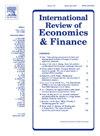一个世纪以来国际股市的罕见灾难和波动性与偏度之间的多层溢出效应:地缘政治风险的作用
IF 5.6
2区 经济学
Q1 BUSINESS, FINANCE
引用次数: 0
摘要
衡量风险和理解跨市场的风险溢出是每个金融市场参与者和货币当局决策过程的核心。然而,大部分文献将风险视为收益分布的第二时刻(波动率)的函数,这是基于资产收益正态分布的隐含的不切实际的假设。在本文中,我们使用多层方法研究了涉及股票收益模型隐含分布的第二和第三矩的稳健估计的风险溢出;然后,我们评估了地缘政治风险的能力,作为罕见灾害风险的代理,使用机器学习方法预测基于层的风险溢出。结合G7和瑞士从1917年5月至2023年2月的一个世纪的股票指数数据,结果表明:首先,股票市场之间的风险溢出存在于每一层(即波动率和偏度)内,且波动率层的影响更强。其次,风险溢出在两层之间非常显著,突出了风险信息的各个方面如何在主要股票市场之间传递。第三,基于样本外预测,地缘政治风险影响两个风险层的值。具体而言,地缘政治风险的全球措施可以在长达6个月的较短时间内预测风险溢出,而在较长时间内,预测工作受市场特定特征的支配。本文章由计算机程序翻译,如有差异,请以英文原文为准。
Rare disasters and multilayer spillovers between volatility and skewness in international stock markets over a century of data: The role of geopolitical risk
Measuring risk and understanding risk spillover across markets lie at the core of the decision-making process of every financial market participant and monetary authority. However, the bulk of the literature treats risk as a function of the second moment (volatility) of the return distribution, based on the implicit unrealistic assumption that asset returns are normally distributed. In this paper, we examine risk spillovers involving robust estimates of both second and third moments of model-implied distributions of stock returns using a multilayer approach; then, we assess the ability of geopolitical risk, as a proxy for rare disaster risk, to forecast layer-based risk spillovers using machine-learning methods. Considering a century of data on the stock indices of the G7 and Switzerland from May 1917 to February 2023, the results show the following: Firstly, the risk spillover among stock markets exists within each layer (i.e. volatility and skewness), with a stronger effect in the volatility layer. Secondly, the risk spillover is significant across the two layers, highlighting how various aspects of risk information are transmitted across major stock markets. Thirdly, geopolitical risk affects both risk layer values, based on an out-of-sample forecasting exercise. Specifically, global measures of geopolitical risk can forecast risk spillovers at shorter horizons up to 6 months, whereas, at longer horizons, the forecasting exercise is dominated by market-specific characteristics.
求助全文
通过发布文献求助,成功后即可免费获取论文全文。
去求助
来源期刊
CiteScore
7.30
自引率
2.20%
发文量
253
期刊介绍:
The International Review of Economics & Finance (IREF) is a scholarly journal devoted to the publication of high quality theoretical and empirical articles in all areas of international economics, macroeconomics and financial economics. Contributions that facilitate the communications between the real and the financial sectors of the economy are of particular interest.

 求助内容:
求助内容: 应助结果提醒方式:
应助结果提醒方式:


